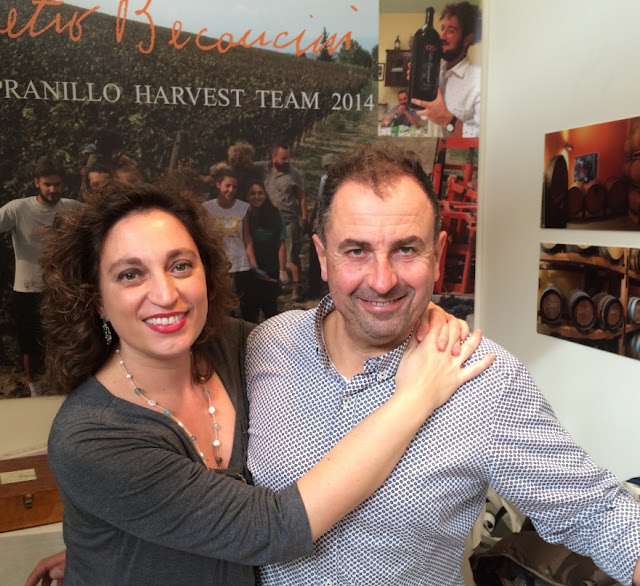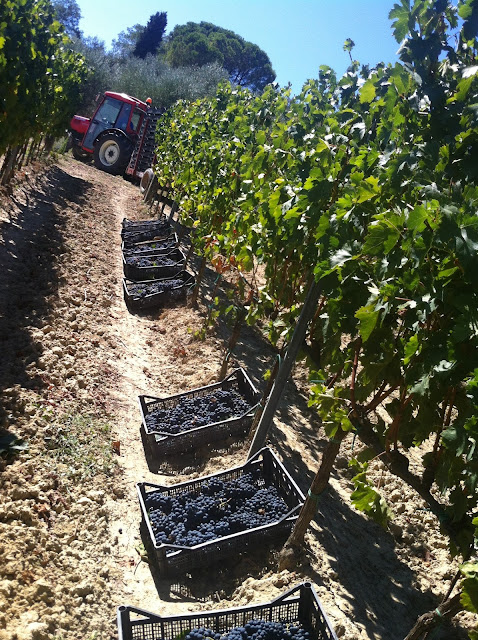Every week a fellow wine blogger,
Katarina of Grapevine Adventures,
features different wineries, sommeliers, winemakers etc with an
opportunity to chat live and ask questions, plus learn a lot about a
particular winery and area. I attend whenever possible and a little
while back she featured a winery in Tuscany that is growing
tempranillo, a spanish grape. I'm always intrigued when wineries
experiment with grapes that either faced extinction or aren't typical
for an area to see what works and what doesn't based on the terroir
of a particular area.
The winery is Pietro
Beconcini located in San Miniato, located between Pisa and
Florence closer to the coast. It's also located along the Via
Francigena, where the pilgrims went from north of Spain to Rome. San
Miniato is also the place of the truffles. So they always think of
the gastronomic side and what wines can be produced to match the food
of the area.
We met virtually with Eva and Leaonardo
the winemaker whom is 4th generation. The winery has been
within the family since the 1950's when the grandfather was a
sharecropper on the land that was then owned by the Marchesi Ridolfi
family. It was an agricultural estate that later became solely
focused on winemaking in the 90's when Leonardo's father transitioned
the land over. Today the wineries total bottle production is
100,000. which is considered a small to medium sized winery.
The soil of Pietro Beconcini in San
Miniato is made up of seashells and clay. Lots of calcium and
minerals are within the soil leading to wines that are fresh and that
provide structure and saltiness.
The grapes that are produced at Pietro
Beconcini are malvasia nera, cieliegiolo, sangiovese, canaoilo and
the unique tempranillo. Leonardo's father first started out
producing chianti in the old fashioned straw fiascos. When Leonardo
took over as winemaker he selected the best vines and vineyard and
started replanting ungrafted vines, meaning they survived the
terrible phylloxera disease that hit most of Europe's vines
destroying them in the 70's. There were 100 year old vines mixed in
with others. He did research and micro-vinifciation on some of the
vines and that is when he discovered it was tempranillo growing in
2004, very unusual for Italy.
 |
| Eva & Leonardo Beconcini |
 |
| Soils of fossil shells and clay |
One of the changes from the 90’s that
Leonardo changed was the types of barrels used. Previously they used
small wooden barrels and now their wine is stored in big wooden
slavonian oak barrels. Their reason for doing so is to go back to
tradition. Small barrels change the style of the wine. With
slavonian oak the impact of wood isn’t aggressive to the wine.
- Reciso Rosso Toscano IGT – Comes from the verb, recidere, which means to cut, for the efforts of the amount of grapes they cut from their vineyards. Made of 100% sangiovese. This is their best sangiovese from the old vineyards. This wine can last 20 years or more.
- Vigna alle Nicchie Tempranillo IGT - Meaning vines in the shells this wine is made fully from the tempranillo grape. Leonardo thinks this wine can be aged for 30 years, but they yet have the experience with it since they started only in 2004. The grapes comes from quite a small vineyard. Before pressing the grapes they dry them for 4 weeks where the grapes lose 30% of the water and produces a more concentrated wine. 15.5% alcohol. Recommended to serve with wild boar or wild white meat or pheasant. Also, duck with pepperoni or orange juice cooked for hours so it's well integrated with the meat. Maybe also just pasta with ragu and vegetables.
- Pietro Beconcini Chianti Riserva DOCG– Produced in large oak barrels from 65 year old vines.
- Fresco di Nero Rose – This is a rose, or rosato, made of tempranillo. The juice is only macerated with the skins for 3 days. Recommended pairings include salmon and tuna or egg with white truffle on top. They also use a lot of cold cuts because of the fatiness and acidity pairs well with the rosato.
Their dessert wine that
is harvested at the beginning of September. They then hang the
grapes to dry for some months. about 5-6 months. The juice is then
stored in chestnut or oak casks where they leave 1/3 of the barrel
for oxygen to never be opened again until it's time to bottle around
5-6 years later. The grapes make up malvasia bianca, colombano and
malvasia nera. Pairings with vin santo include blue cheese or
gorgonzola, stilton. Liver pate is a tradition of the area. If
you're a cigar lover this will be a pairing for you.
*All pictures used with permission of Pietro Beconcini



No comments:
Post a Comment